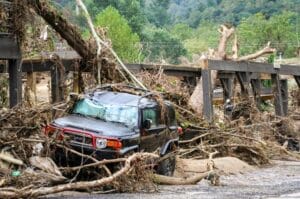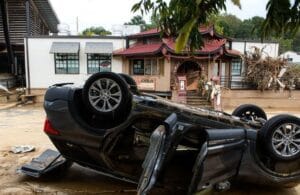Hurricane Milton is making headlines as it rapidly intensifies in the southern Gulf of Mexico, posing a significant threat to the Tampa Bay area. With the storm’s recent escalation into a Category 5 hurricane, understanding the potential impact—particularly from storm surges—is crucial for residents and visitors alike. In this article, we’ll delve into the mechanics of storm surge, the current forecasts for Tampa Bay, and what you can do to prepare for the impending storm.
Understanding Hurricane Milton
What is Hurricane Milton?
Hurricane Milton isn’t just another storm; it’s a powerful hurricane that has undergone “explosive intensification” over a short period. Originating as a tropical storm just a day before, it rapidly gained strength, with sustained winds now reaching upwards of 180 mph. Such rapid changes can leave little time for communities to prepare, making it vital to stay informed and ready for what’s to come.
Recent Developments and Rapid Intensification
As of the latest advisories, Milton’s trajectory has shifted towards Florida’s western coast. This change means that the impacts on areas like Tampa Bay could be more severe, especially as the storm continues to intensify. The National Hurricane Center (NHC) has been monitoring the situation closely, providing updates on its strength and potential landfall.
The Mechanics of Storm Surge
Definition and Causes of Storm Surge
Storm surge refers to the rise in seawater level caused by the wind and atmospheric pressure changes associated with a storm. Unlike regular tidal flooding, which is predictable, storm surge can be sudden and catastrophic. It occurs when high winds push seawater towards the shore, leading to dangerously high water levels.
How Storm Surge Differs from Regular Tidal Flooding
While tides rise and fall predictably, storm surge can vary drastically based on several factors, including the storm’s intensity, speed, and direction. This unpredictability makes storm surge one of the most hazardous aspects of hurricanes, particularly for coastal communities like Tampa Bay.
The Factors Influencing Storm Surge
Wind Speed and Direction
The strength of a hurricane directly affects the storm surge it generates. Higher wind speeds push more water towards the coast, while the direction of those winds can also change the way the water accumulates. Milton’s wind speeds have recently increased, raising concerns about the potential for severe storm surge.
Ocean Depth and Geography of the Gulf Coast
The Gulf of Mexico has shallow waters, which can amplify the effects of storm surge. As the storm approaches land, the shallow water allows for a more pronounced rise in water levels. This is especially relevant for Tampa Bay, where geography plays a significant role in how storm surge impacts the area.
The Role of the Hurricane’s Eye and “Dirty Side”
The “eye” of the hurricane is the calm center, but it’s the surrounding areas that pose the greatest threat. The eastern side of the storm, often referred to as the “dirty side,” typically experiences the most severe winds and storm surge. If Milton tracks northward as predicted, the dirty side could fall directly over Tampa Bay, increasing the risk of flooding.
The Impact of Hurricane Milton’s Intensity
Recent Wind Speed Updates
Milton’s wind speeds have dramatically increased, now classified as a strong Category 5 hurricane. This escalation not only intensifies the storm but also raises the forecast for potential storm surge heights in the Tampa Bay area.
Predictions for Storm Surge Heights
The NHC has revised its peak storm surge forecasts for the region. Originally predicted at 8-12 feet, the updated forecast now suggests a staggering 10-15 feet of inundation for areas from Anclote River to Tampa Bay. This increase is alarming and highlights the need for immediate action from residents.
Current Forecasts for Tampa Bay
Peak Storm Surge Predictions for the Region
As Hurricane Milton continues its approach, the risk of storm surge in Tampa Bay is more pressing than ever. Coastal residents should be prepared for potentially devastating flooding, especially during high tide.
Areas Most at Risk of Flooding
Some areas are more susceptible to flooding than others. Low-lying regions and coastal communities will face the brunt of the storm surge. If you live in these areas, it’s essential to take evacuation orders seriously and prepare for potential water intrusion.
Evacuation Orders and Safety Measures
Overview of Evacuation Orders in Place
Local officials have begun issuing evacuation orders for at-risk areas. It’s crucial for residents to heed these warnings and act quickly to ensure their safety. These orders are based on the latest forecasts and assessments of risk.
Tips for Residents to Prepare for the Storm
- Have an Emergency Kit Ready: Stock up on essentials like water, non-perishable food, medications, flashlights, and batteries.
- Secure Your Property: Bring in outdoor furniture and secure windows to minimize damage.
- Stay Informed: Regularly check updates from reliable sources like the NHC and local news.
Historical Context: Storm Surges in Tampa Bay
Previous Hurricanes and Their Impacts on the Area
Tampa Bay has faced its share of hurricanes, each with varying levels of impact. Understanding the historical context can provide valuable insights into what communities might expect during Hurricane Milton.
Lessons Learned from Past Storm Surges
Past hurricanes have taught valuable lessons about preparation and response. Communities that took proactive measures often fared better than those that didn’t. This history underscores the importance of being ready before the storm hits.
Community Preparedness and Resources
Local Resources for Residents
Residents should take advantage of local resources, such as shelters and community centers, which can provide safety during a hurricane. Many organizations also offer assistance for emergency kits and preparation strategies.
Community Initiatives to Prepare for Hurricanes
Local governments often run initiatives to educate the public about hurricane preparedness. Engaging with these programs can help ensure that individuals and families are well-prepared for storm impacts.
Understanding Emergency Alerts
How to Stay Updated with Reliable Information
Staying informed during a hurricane is crucial. Follow local news stations and weather channels for real-time updates. Social media can also be a helpful tool, but ensure the sources are credible.
The Importance of Following Local Authorities
Local officials are the best source of information during a storm. Their guidance can help ensure safety and minimize risks. Following evacuation orders and safety recommendations is vital.
The Science Behind Hurricane Tracking
How Meteorologists Predict Storm Paths
Meteorologists use a combination of satellite imagery, weather models, and historical data to predict hurricane paths. Understanding these processes can provide insights into why certain forecasts change and what that means for residents.
Tools Used for Tracking Hurricanes and Storm Surges
Advancements in technology have improved the accuracy of hurricane tracking. Tools like Doppler radar and computer models play crucial roles in forecasting storm behavior and impacts.
The Role of Technology in Disaster Management
Advancements in Hurricane Tracking Technology
Technological innovations have made it easier to predict and respond to hurricanes. These advancements allow for faster updates and more accurate forecasting, ultimately saving lives.
How Technology Helps Communities Prepare and Respond
From early warning systems to
emergency alert apps, technology plays a significant role in how communities prepare for storms. Leveraging these resources can help residents stay informed and ready.
What to Expect in the Coming Days
Timeline of Hurricane Milton’s Approach
Residents should prepare for the storm in the coming days. As the storm moves closer, forecasts will become more precise. Keeping an eye on updates is essential for planning.
Key Dates for Residents to Keep in Mind
Pay attention to projected landfall dates and potential evacuation orders. Marking these dates on your calendar can help you stay organized and prepared.
What Should Residents Do Now?
Immediate Steps to Take as the Storm Approaches
If you haven’t already, it’s time to finalize your hurricane preparation plans. Review your emergency kit, secure your property, and make a plan for evacuation if needed.
Supplies and Preparations for a Potential Evacuation
Don’t wait until the last minute to gather supplies. Water, food, medications, and other essentials should be collected now to ensure you’re ready if an evacuation becomes necessary.
Also read:
Derek Carr | Derek Carr Injury
Conclusion
Hurricane Milton poses a significant threat to Tampa Bay, with the potential for severe storm surge and flooding. As the storm intensifies and approaches land, it’s crucial for residents to stay informed, heed evacuation orders, and take necessary precautions. Preparedness is key to weathering this storm, and together, we can enhance our community’s resilience in the face of adversity.
FAQs
-
What is storm surge, and why is it dangerous?
- Storm surge is the rise in seawater caused by a storm’s winds and pressure changes. It can lead to catastrophic flooding, often more severe than regular tidal flooding.
-
How can I prepare my home for Hurricane Milton?
- Secure outdoor items, check your emergency kit, and consider boarding up windows. Stay informed about evacuation orders and follow local guidelines.
-
What areas in Tampa Bay are at the highest risk for flooding?
- Low-lying coastal areas, especially near the mouth of rivers, are at higher risk for flooding. Always check local advisories for the most accurate information.
-
How can I stay updated on Hurricane Milton’s path?
- Follow reliable sources such as the National Hurricane Center, local news stations, and official emergency management accounts on social media.
-
What resources are available for hurricane preparedness in Tampa Bay?
- Local emergency management agencies provide resources, including shelters, emergency kits, and preparedness guides. Check with your city or county’s website for specific information.



